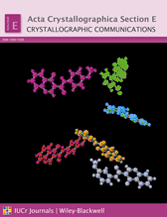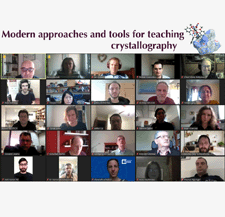issue contents
June 2024 issue
Early view articles

research communications
Download citation


Download citation


The title compounds are two calix[4]arenes with a pinched cone conformation and one with a 1,3-alternate conformation.
Download citation


Download citation


The title compound, C12H10N2O3, was obtained by the deacetylation reaction of 1-(6-amino-5-nitronaphthalen-2-yl)ethanone in a concentrated sulfuric acid methanol solution. The molecule comprises a naphthalene ring system bearing an acetyl, amino and nitro groups. In the crystal, the molecules are assembled into a two-dimensional network by N⋯H/H⋯N and O⋯H/H⋯O hydrogen-bonding interactions. n–π and π–π stacking interactions are the dominant interactions in the three-dimensional crystal packing.
CCDC reference: 2350991
Download citation


Download citation


In the PdII complex, two substituted 3-(pyridin-2-yl)-1,2,4-triazole ligands in the neutral form coordinate to the metal atom through the pyridine-N and triazole-N atoms in a trans-configuration.
CCDC reference: 2352083
Download citation


Download citation


In the crystal, molecules are connected by C—H⋯O hydrogen bonds, forming C(8) chains running along the a-axis direction. Cohesion of the packing is provided by weak van der Waals interactions between the chains.
CCDC reference: 2352378
Download citation


Download citation


The competition between gauche and anti conformations in 2-chloroethyl- or 3-chloropropyldimethylammonium cations is investigated for the title tetrachlorometallate salts in which the alkyl chain is found to disordered with the gauche conformation dominant.
Download citation


Download citation


In the crystal, molecular pairs are connected by N—H⋯N hydrogen bonds, forming dimers with an ![[R_{2}^{2}]](/e/issues/2024/06/00/tx2085/teximages/tx2085fi1.svg) (8) motif. The dimers are linked into layers parallel to the (10
(8) motif. The dimers are linked into layers parallel to the (10![[\overline{4}]](/e/issues/2024/06/00/tx2085/teximages/tx2085fi2.svg) ) plane by N—H⋯O hydrogen bonds. In addition, C—O⋯π and C—Br⋯π interactions connect the molecules, forming a three-dimensional network.
) plane by N—H⋯O hydrogen bonds. In addition, C—O⋯π and C—Br⋯π interactions connect the molecules, forming a three-dimensional network.
CCDC reference: 2352897
Download citation


Download citation


Very large high-quality crystals of a new member of the family of double nitrates, namely, [La(NO3)6]2[Ni(H2O)6]3·6H2O, were crystallized in large amounts. The structure was determined via single-crystal X-ray diffraction to high resolution. Extensive structural information, including hydrogen-bonding details, was obtained at the same time.
CCDC reference: 2348374
Download citation


Download citation


This study presents two anhydrous polymorphic forms of psilocin, detailing their crystal structures and hydrogen-bonding differences, with Form II introducing a novel conformation and whole-molecule disorder.
Download citation


Download citation


The title multi-component crystal, [Cu(NH3)5]Cl2·CO(NH2)2, was synthesized from a deep eutectic solvent to yield an unusual pentaaminecopper(II) complex. Hydrogen bonding takes place between chloride ions and both the pentaaminecopper ions and urea molecules.
CCDC reference: 2354149
Download citation


Download citation


In the title molecule, the benzimidazole entity is almost planar (r.m.s. deviation = 0.0262 Å), while the triazole ring is oriented almost perpendicular to the benzimidazole ring. In the crystal, bifurcated C—H⋯O hydrogen bonds link individual molecules into layers extending parallel to the ac plane.
CCDC reference: 2352892
Download citation


Download citation


The crystal structure of LiLu[MoO4]2, which emerged as a by-product of the synthesis to obtain lithium derivatives of lutetium molybdate, adopts the scheelite type.
CCDC reference: 2312843
Download citation


Download citation


In the title compound, the dihydroquinoxaline units are both essentially planar and the dihedral angle between their mean planes is 64.82 (2)°. In the crystal, C—H⋯O hydrogen bonds form chains along the b-axis direction which are joined by π-stacking and C—H⋯π(ring) interactions into the full three-dimensional network structure.
CCDC reference: 2354488
Download citation


Download citation


In the crystal, the molecules are connected into dimers by C—H⋯O hydrogen bonds with ![[R_{2}^{2}]](/e/issues/2024/06/00/nx2010/teximages/nx2010fi1.svg) (8) ring motifs, forming zigzag ribbons along the b-axis direction.
(8) ring motifs, forming zigzag ribbons along the b-axis direction.
CCDC reference: 2354123
Download citation


Download citation


The reaction between lithium hexamethyldisilazane, [Li{N(Si(CH3)3)2}] (LiHMDS), with 4,4-dimethyl-2-phenyl-2-oxazoline (Phox) in hexane produced the title complex [Li{N(Si(CH3)3)2}(Phox)2]. The molecule, which crystallizes in the C2/c space group, lies on a twofold rotation axis and the lithium cation adopts a trigonal–planar coordination environment by the coordination, through nitrogen atoms, of one unit of hexamethyldisilazane and two units of Phox, both ligands in a monodentate mode.
CCDC reference: 2354028

 journal menu
journal menu


































